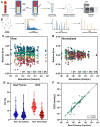Use of a Novel Whole Blood Separation and Transport Device for Targeted and Untargeted Proteomics
- PMID: 39457630
- PMCID: PMC11504527
- DOI: 10.3390/biomedicines12102318
Use of a Novel Whole Blood Separation and Transport Device for Targeted and Untargeted Proteomics
Abstract
Background: There is significant interest in developing alternatives to traditional blood transportation and separation methods, which often require centrifugation and cold storage to preserve specimen integrity. Here we provide new performance findings that characterize a novel device that separates whole blood via lateral flow then dries the isolated components for room temperature storage and transport.
Methods: Untargeted proteomics was performed on non-small cell lung cancer (NSCLC) and normal healthy plasma applied to the device or prepared neat.
Results: Significantly, proteomic profiles from the storage device were more reproducible than from neat plasma. Proteins depleted or absent in the device preparation were shown to be absorbed onto the device membrane through largely hydrophilic interactions. Use of the device did not impact proteins relevant to an NSCLC clinical immune classifier. The device was also evaluated for use in targeted proteomics experiments using multiple-reaction monitoring (MRM) mass spectrometry. Intra-specimen detection intensity for protein targets between neat and device preparations showed a strong correlation, and device variation was comparable to the neat after normalization. Inter-specimen measurements between the device and neat preparations were also highly concordant.
Conclusions: These studies demonstrate that the lateral flow device is a viable blood separation and transportation tool for untargeted and targeted proteomics applications.
Keywords: LC-MS/MS; lateral flow; mass spectrometry; plasma proteomics.
Conflict of interest statement
Colin T. McDowell, Amanda L. Weaver, Nathan K. Keiser, Charles M. Nichols and Gary A. Pestano either are or were employed by Biodesix, Inc. The remaining author declares that the research was conducted in the absence of any commercial or financial relationships that could be construed as a potential conflict of interest.
Figures







Similar articles
-
Design and Characterization of a Novel Blood Collection and Transportation Device for Proteomic Applications.Diagnostics (Basel). 2020 Dec 2;10(12):1032. doi: 10.3390/diagnostics10121032. Diagnostics (Basel). 2020. PMID: 33276497 Free PMC article.
-
Method and platform standardization in MRM-based quantitative plasma proteomics.J Proteomics. 2013 Dec 16;95:66-76. doi: 10.1016/j.jprot.2013.07.026. Epub 2013 Aug 7. J Proteomics. 2013. PMID: 23933160
-
Proteomic Analysis of Whole Blood Using Volumetric Absorptive Microsampling for Precision Medicine Biomarker Studies.J Proteome Res. 2022 Apr 1;21(4):1196-1203. doi: 10.1021/acs.jproteome.1c00971. Epub 2022 Feb 15. J Proteome Res. 2022. PMID: 35166117
-
[Applications of high performance liquid chromatography-mass spectrometry in proteomics].Se Pu. 2024 Jul;42(7):601-612. doi: 10.3724/SP.J.1123.2023.11006. Se Pu. 2024. PMID: 38966969 Free PMC article. Review. Chinese.
-
[Methods and applications of single-cell proteomics analysis based on mass spectrometry].Se Pu. 2021 Feb;39(2):142-151. doi: 10.3724/SP.J.1123.2020.08030. Se Pu. 2021. PMID: 34227347 Free PMC article. Review. Chinese.
References
LinkOut - more resources
Full Text Sources

